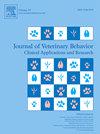Quantifying the influence of cut tree branches on zoo giraffe behavior during and post browsing: A case study on five animals and four tree species
IF 1.3
3区 农林科学
Q4 BEHAVIORAL SCIENCES
Journal of Veterinary Behavior-clinical Applications and Research
Pub Date : 2025-07-01
DOI:10.1016/j.jveb.2025.05.005
引用次数: 0
Abstract
The nutrition of captive species profoundly affects their physical, behavioral, and psychological wellbeing. Determining a species’ ideal zoo diet remains challenging, necessitating assessment of an animal’s responses to their diet to establish best practices, including any effects on behaviors. This study investigates the behavioral responses of five female giraffes (Giraffe camelopardalis) to browse from four tree species (willow, Salix caprea; hawthorn, Crataegus monogyna; hazel, Corylus avellana; oak, Quercus robur). This study aimed to assess the effect of browse species on giraffe activity and to identify which of these species was most associated with performance of key welfare indicators. Given this species’ adaptations to foraging on spinose (i.e., thorny) trees, we predicted that hawthorn would have the largest effect on giraffe behavior. Focal sampling of individual giraffes was conducted, with equal repetitions for each browse species, across spring and summer 2021 and 2022 at Marwell Zoo. Giraffes were observed for an hour with browse, followed by an additional hour after a 30-minute pause to quantify post-browsing behaviors. Results suggest that willow increased overall browsing time, while oak elicited prolonged interaction with initial browse branches. Willow promoted the highest bark stripping and bite counts, while oak and willow increased time ruminating. Contrary to expectation, hawthorn, with its thorny defences, did not significantly extend browsing or rumination. Social context also influenced browsing behavior with heightened browsing activity occurring when giraffe browsed with other species present. While a case study of four tree species at one zoo, our results show the importance of measuring and assessing animal choice and preferences (regarding their engagement with husbandry) to underpin best practice approaches to care and welfare.
砍断的树枝对动物园长颈鹿在浏览过程和浏览后行为的影响——以5只动物和4种树种为例
圈养物种的营养会深刻影响它们的身体、行为和心理健康。确定一个物种的理想动物园饮食仍然具有挑战性,需要评估动物对饮食的反应,以建立最佳实践,包括对行为的任何影响。本文研究了5只雌性长颈鹿(Giraffe camelopardalis)对4种树种(柳、柳和柳)的觅食行为反应。山楂,山楂;榛子,榛木;橡树,栎树)。本研究旨在评估浏览物种对长颈鹿活动的影响,并确定哪些物种与关键福利指标的表现最相关。考虑到这个物种适应在多刺的树上觅食,我们预测山楂对长颈鹿行为的影响最大。在2021年和2022年的春季和夏季,在马维尔动物园对单个长颈鹿进行了集中抽样,对每种浏览物种进行了相同的重复。研究人员对长颈鹿进行了一个小时的浏览观察,然后在30分钟的暂停后再观察一个小时,以量化浏览后的行为。结果表明,柳树增加了总体的浏览时间,而橡树则延长了与初始浏览树枝的相互作用。柳树促进树皮剥落和咬伤次数最高,而橡树和柳树增加了反刍时间。与预期相反,山楂的防御物多刺,并没有显著延长人们的浏览或反刍时间。社会环境也会影响长颈鹿的浏览行为,当长颈鹿与其他物种一起浏览时,浏览活动会增加。通过对一个动物园的四种树种的案例研究,我们的结果显示了测量和评估动物的选择和偏好(关于它们与畜牧业的参与)对于支持护理和福利的最佳实践方法的重要性。
本文章由计算机程序翻译,如有差异,请以英文原文为准。
求助全文
约1分钟内获得全文
求助全文
来源期刊
CiteScore
3.50
自引率
16.70%
发文量
107
审稿时长
325 days
期刊介绍:
Journal of Veterinary Behavior: Clinical Applications and Research is an international journal that focuses on all aspects of veterinary behavioral medicine, with a particular emphasis on clinical applications and research. Articles cover such topics as basic research involving normal signaling or social behaviors, welfare and/or housing issues, molecular or quantitative genetics, and applied behavioral issues (eg, working dogs) that may have implications for clinical interest or assessment.
JVEB is the official journal of the Australian Veterinary Behaviour Interest Group, the British Veterinary Behaviour Association, Gesellschaft fr Tierverhaltensmedizin und Therapie, the International Working Dog Breeding Association, the Pet Professional Guild, the Association Veterinaire Suisse pour la Medecine Comportementale, and The American Veterinary Society of Animal Behavior.

 求助内容:
求助内容: 应助结果提醒方式:
应助结果提醒方式:


